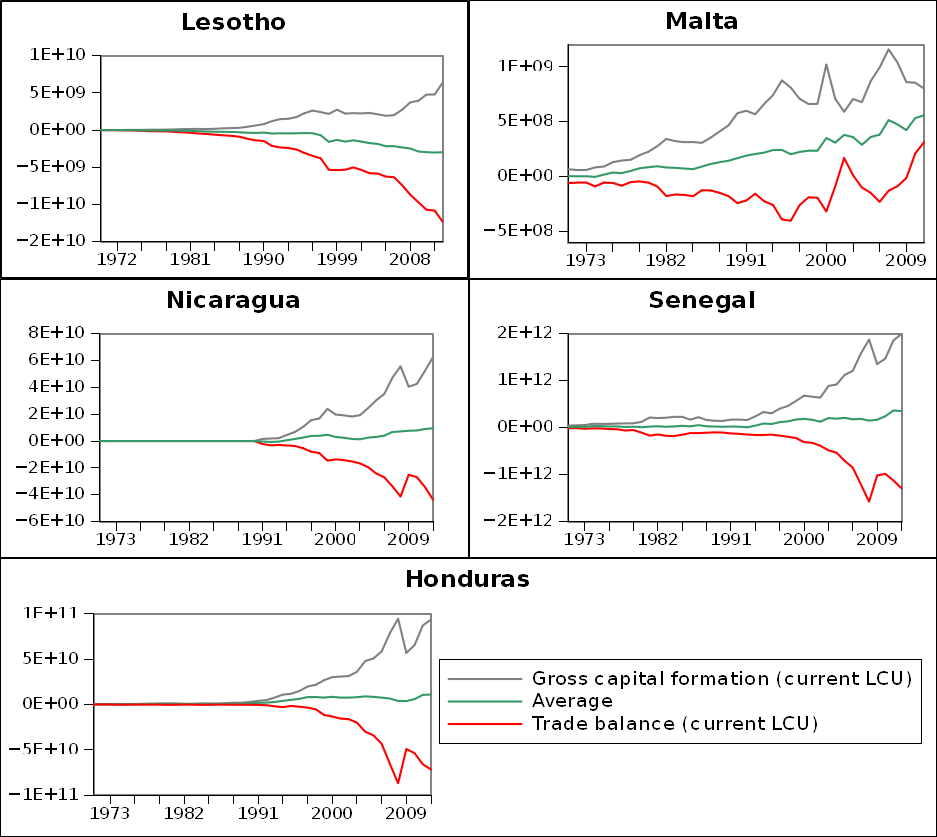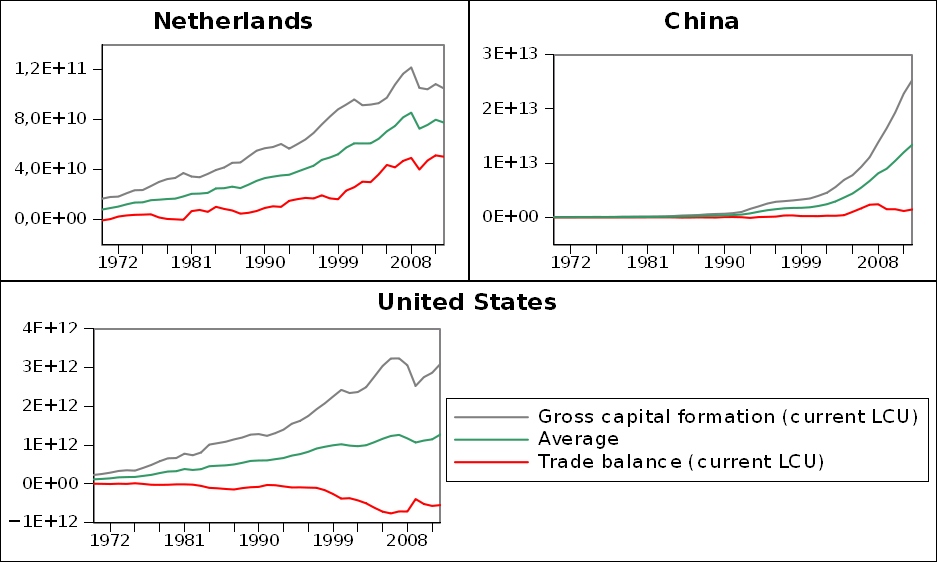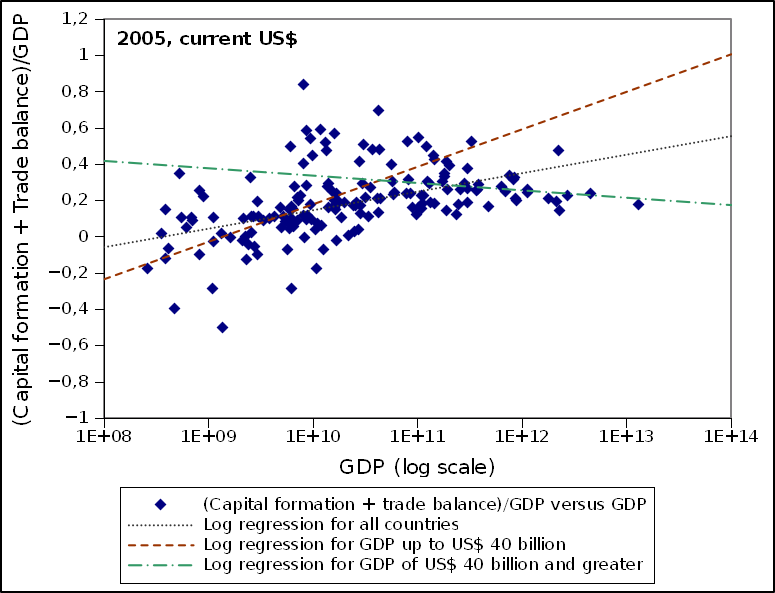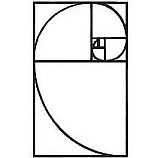Economy as the value streams. Preliminary study.
Economy can be generally described as a bunch of value streams. At least a part of capital accumulation is assumed to be the consequence of value stream blockage, and a means too keep such blockage. Negative relation between capital accumulation and foreign trade balance coming out from this assumption is supported by the data from national accounts, and hence justify the idea of economy as the value streams. A lot of research ideas are following this assertion, most of them promising results useful for socio-economic policies, and for optimizing institutions and business practices in order to make them more conductive to capital flows.
Andrzej Góralczyk
First published in MPRA on 17 March, 2014
European Institute of Social and Industrial Engineering in organisation.
The work has been partially financed by Business Dialog Iwona D. Bartczak.
Author is grateful to Marcin Jurdziński from the University of Warwick for valuable discussions.
Introduction
Social sciences, including economics, sometimes use metaphors and concepts borrowed from natural sciences. The concept of equilibrium, borrowed from physics, is widely used as a central basis of economic theory. There are some exceptions. For example, proponents of the idea of Cumulative Causation focus on the irreversible changes of institutions [1]. My approach stems from the remark that as natural sciences mature, they adopt more general and fundamental concept of stability of certain streams. Now, when the global crisis touched also economic theory, it is good opportunity to push economic thinking in the same direction.
In this paper I argue that negative relationship between capital accumulation and foreign trade justify the idea of perceiving economy as the value streams. Next, I outline some fields of research employing this idea and potentially leading to the solutions for better socio-economic policies, and for institutions and economic practices more conductive to the flows of “working capital”.
Value streams
Exactly speaking, value stream is the stream of “value carriers” or valuable “things”. For simplicity, we call them “value streams”.
The very basic and perfect bunch of value streams consists of two streams flowing in opposite directions. For example, steady and continuous delivery of some goods against immediate, steady and continuous flow of other value in exchange for this good. We can consider such perfect flow of values as the stable value stream(s).
In practice, we do not observe value streams fulfilling above conditions. Usual case is the backlog in the flow of some streams in relation to the opposite streams. For example, if the flow of goods has no outfall, we can observe increased inventory, and increased working capital is necessary to finance keeping this inventory. Another example is the investment giving delayed return. Interestingly, it suggests that the economic growth can be induced by the imperfection or instability of value streams.
For most organisation levels we should relax what we mean “immediate”. For example, at the enterprise level, monthly wage payment for the workers could be considered as immediate despite the fact that weekly or daily payments require less working capital. For economy sectors or national economy we often use quarterly or yearly records of such value flows as savings, investments, debt service etc. Accordingly, we could examine how such data in long time series diverge from the trend, when looking for instabilities of value streams.
Real economy, capital accumulation and trade balance
National economy can be seen as a source of the stream of goods and services. National accounts provide the value of those bought from the economy within a year. It is a sum of final consumption and net export. I call this figure Net Domestic Sales. Some countries sell more than consume and it is reflected as surplus of foreign trade, and some countries sell less than consume, and the gap is filled by net import.
At the enterprise level during tough times, when sales drops or slows down, inventories tend to grow or to accelerate. Usually it is reported as “rebuilding inventories”. However, it can also be seen as investing a part of working capital which got unnecessary to finance current production. In national accounts, inventories are included in gross capital formation, together with other assets as receivables, retained profits etc. Moreover, for majority of countries final consumption is rising hand in hand with overall economy growth and shows very small relative deviations from the trend, unlike trade balance or investments. So, we can expect rise of capital formation when trade balance falls and fall of capital formation when trade balance improves.

Fig. 1. Capital formation and trade balance of selected small economies
Data in current local currencies (LCU).
Source: World Development Indicators, The World Bank.
Time series of gross capital formation and trade balance are plotted in Fig. 1. and Fig. 2., for some small and some big economies respectively. Also the “Average” of both time series is plotted in order to show that they are almost symmetrical against certain “trend”. In fact, there are few small economies with “Average” trend going so near zero as those shown in the Fig.1., however, the symmetry around “Average” is visible more or less clearly for majority of the countries in the world. There are also a handful of countries showing no symmetry at all. It has to be noted that the “Average” can be expressed in the terms of national accounts as Gross domestic savings/2. However, I don’t want to rely on the meaning suggested in the name of this variable, and therefore I call “Capital in Hand” to denote double “Average”.
It seems to be hard to speculate whether investment is partially consumed by net import or import is the source of investment etc. Instead, in this preliminary study I suspect that the phenomenon described reflects limitations of the Capital in Hand which can be put into work. Simply speaking, domestic consumption and export compete for the “work” of this limited capital. Therefore, I expect that near zero “Average” and high symmetry of both time series are characteristic to small economies. However, there are pros and cons for this hypothesis. For example, the symmetry is met also for some biggest economies in the world, as can be seen in Fig. 2.

Fig. 2. Capital formation and trade balance of selected big economies
Data in current local currencies (LCU).
Source: World Development Indicators, The World Bank.
For further exploratory study of above hypothesis I used GDP, in current US$, as a measure of the size of economy. I also selected years 2003 and 2005 as those of “calm” economy growth in the world, basing on the review of time series from all 169 countries which provided enough data. In the Fig. 3., Capital in hand/GDP is plotted against GDP for 2005. The data show rather weak positive logarithmic trend. Similar results are for 2003.
Attentive look at the plot in Fig. 3. reveal some qualitative details. It seems that for big economies the logarithmic trend is flat with a weak tendency to fall, and that small economies contribute to almost all positive correlation. The division of both groups in 2005 seems to lie about US$ 40 billion of GDP.

Fig. 3. Capital in hand/GDP versus GDP in 2005 for 169 countries.
Source: World Development Indicators, The World Bank.
For about 20 randomly chosen countries I compared “Average” time series with a handful of series of other macroeconomic variables like money aggregate M2, debt stock and debt service, domestic credit, foreign assets, reserves etc. and found no systematic correspondence.
Issues and inspirations for further studies
I consider results presented above strongly supporting the idea of understanding economy as the value streams. Developing this idea to the stage of fairly mature framework would take a lot of doing. Below I outline what I actually see as promising fields of investigation.
Criteria for stability of economy, i. e. stability of value streams. Smoothness of continuous flow (or minimum dispersion of flow rates along the trend) of goods and services could be considered as such criterion. At the level of enterprise also Lean Production or Just In Time are considered as “ideal” because they minimize the “safety” working capital required to assure certain level of elasticity (ease of change) of the process. The same rule holds for Supply Chain Management. Criteria of smoothness and minimum backlog could allow integration of microeconomics and macroeconomics.
Another case is sometimes called “external imbalances”. It means that some countries rely on large trade surplus while some other countries have to keep trade deficit because overall global trade balance sums to zero (in theory). In the terms of value streams, we could say that despite these imbalances value streams can be stable. However, disturbances of the flows occur and can be dangerous. “When some countries want to run smaller deficits without a corresponding desire by others to reduce surpluses, the result is the exportation of unemployment and a bias toward deflation /../. When some want to reduce their surpluses without a corresponding desire by others to reduce deficits, the result is a ‚sudden stop’ in capital flows and financial crisis. As external imbalances grow larger, each phase of this cycle becomes more painful” [4].
I hope that a set of indexes of stability could be used as a tool for early warning of impending economic crisis. However, the question would arise whether the growth of economy is related to the imperfection or instability of value streams.
Economy growth seems to be most promising research filed as conventional theories are challenged by recent facts and figures. For example, a number of OECD studies reveal that some developed economies modestly grow despite slowing down or decreasing productivity together with technology simplifications and falling quality of human capital of employed labour force. New answers are badly needed for the use in socioeconomic policies, such as what really fuels the growth, whether growth really reduces unemployment etc.
Some macroeconomic variables exhibit growth along with overall economy growth. The growth of final consumption seems to best fit GDP growth for the majority of countries. However, for Upper Middle Income group of countries and richer ones (according to OECD classification), time series of many macroeconomic variables are related each to other with power law relation. For example growth of money supply measured as Broad money is related with power law to the growth of gross capital formation, GDP, FDI, Domestic credit, etc. Data for groups of poorer countries fit better to linear relations.
Weak analogy to metabolism. In search of power law relations examined by the natural sciences, I found an analogy in allometry. The analogy is not new in economy as Luis Bettencourt et al. [2] and others investigate nonlinear scaling of infrastructure in towns and cities. More promising for me are the inspirations from the research on metabolism in living organisms [3] which we can treat as rough analogy to processing and transport of value carriers through the nets of channels of definable topology. I guess that power law relations reflect constraints imposed on the value streams by institutional environment, business practices etc. Results of such studies could be applied in optimisation of institutional environment and arrangements of economic activities.
Reaction to the economic shocks is usually described as a wave-like time series of certain macroeconomic variable. Conventionally, the waves are studied using autoregression models. However, problematic is that the results are very sensitive on the choice of endogenous and exogenous variables and on the way of preprocessing them. I would prefer to study more raw data series like those of receivables and liabilities at least at the sector or branch level. Promising is that in this way I found some symptoms of a turbulence of value streams in the reaction of Polish producers and retail sectors to the fiscal shock of 2011.
Wave-like behaviour suggests another analogy – that of propagation of the pulse in elastic environment with dissipation. Actually, I suspect that the wave corresponds to capital shifts between sectors, and its decline reflects reduction of the overall loss of capital. Again, results of such research could be of big practical value.
New institutional economics and complexity economics could probably serve as another sources of inspiration and research results as many of them seem to relate to the research ideas outlined above.
* * *
The idea of optimising institutions and economic practices in order to make them more conductive to the flow of capital is stunning. But first we should find ways to aggregate data at various organisation levels and to relate Capital in Hand to working capital.
References
- Sebastian Berger, The Foundations of Non-equilibrium Economics: The Principle of Circular and Cumulative Causation. London [u.a.] : Routledge, 2009.
- Luís M. A. Bettencourt, José Lobo, Dirk Helbing, Christian Kühnert, and Geoffrey B. West , Growth, innovation, scaling, and the pace of life in cities, PNAS 2007 104 (17) 7301-7306; published ahead of print April 16, 2007, doi:10.1073/pnas.0610172104
- James H. Brown, James F. Gillooly, Andrew P. Allen, Van M. Savage, and Geoffrey B. West 2004. TOWARD A METABOLIC THEORY OF ECOLOGY. Ecology 85:1771–1789.
- Dani Rodrik, The Real Heroes of the Global Economy, in Project Sindicate, Nov 13, 2013, http://www.project-syndicate.org/commentary/dani-rodrik-on-the-large-dangerous-external-imbalances-that-underpin-the-fastest-growing-economies–performance


Najnowsze komentarze